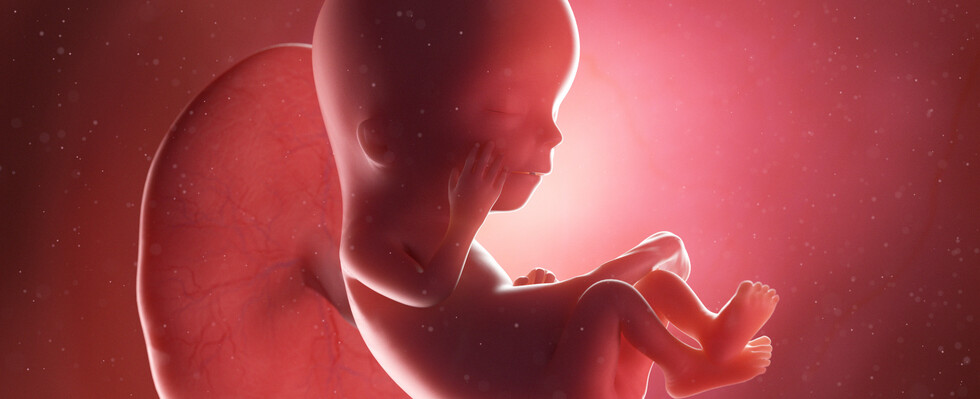St Thomas Aquinas and Abortion
By Dr William Newton FAITH MAGAZINE March-April 2014
Dr William Newton is associate professor of theology at the Franciscan University of Steubenville.
In a debate with an advocate for abortion, one occasionally comes up against an informed opponent who seeks to undermine the Church’s position on the issue by pointing out that the Universal Doctor of the Church, St Thomas Aquinas, held to the doctrine of delayed animation or hominisation. According to this theory, ensoulment did not occur at conception but only later: for St Thomas at least 40 days later. This, of course, seems to open the door to the possibility of abortion, a fact disquieting to the average pro-life Catholic.
Certainly, it would be easy to respond that Aquinas is not the Magisterium and so he did, very occasionally, get things wrong – the Immaculate Conception being a stellar example. Or, one could point out that even if Aquinas did ascribe to a theory of delayed hominisation, he still held that abortion before ensoulment was wrong, at least to the degree that it is a form of contraception or that it risks killing a “formed” foetus.
''As Vatican II teaches: 'Only in the mystery of the incarnate Word does the mystery of man take on light'.''
These responses are good and useful but I fear they do not do justice to Aquinas for while he was, of course, almost certainly wrong in subscribing to a theory of delayed animation, there remains much truth in his general approach to ensoulment. Therefore, in this short article, I wish to explain St Thomas’s approach and to suggest that his metaphysical principles are ultimately sound. Moreover, I shall suggest that if we were to replace his outmoded embryology with what we now know, the Angelic Doctor himself would be more than likely to conclude that ensoulment took place at the moment of conception.
Aquinas’s Metaphysical Principles
Aquinas’s anthropology is firmly constructed on the foundation of the hylomorphic theory – the idea that all material things are a composite of a material and a formal principle. In the case of the human being, the formal principle is the soul. While it is the form that gives to matter all its particularity, matter itself must be disposed towards the reception of a given form. So, for example, chickpeas must be soaked and cooked if they are to be digested. This boils down (no pun intended) to saying that the matter currently configured as chickpea cannot receive the form of human flesh without first being disposed. Another example, more classically Thomistic, is that wet wood must be disposed – through the process of drying out – to receive the form of fire.
When this notion of disposition is applied to human generation it leads to the conclusion that the material element of the human being that is given by the parents in procreation must be ready to receive a rational soul before it can actually receive it. Remember, the parents themselves do not give the child his form (the spiritual soul) because they only contribute something material, namely a sperm and an ovum; and their own souls – being spiritual and so without parts – cannot divide to provide a soul for their offspring. Hence, the soul must come directly from God through an act of creation, and it is on account of this that we have the term “procreation”.
Given these principles, Aquinas’s approach was to say that the rational soul is infused as soon as the matter of the body is ready for such a form. Now, the rational soul gives to a human being the ability to do typically human activities, such as thinking and willing. While at their highest point such activities, particularly conceptualising, are immaterial and so are not ultimately dependent upon the body, Aquinas held that in this life the whole gamut of rational activity needs various interior sense powers that come with the body. He was quite aware that damage to the body – especially damage to the brain – impeded rational activities like thinking.
The question then becomes: how developed does the body need to be before we can say that it is ready for the rational soul? Aquinas certainly did not think that the brain needed to be fully developed. He knew that the bodily component to rational thinking was not fully developed until well after birth, since children are not capable of rational thinking until after early childhood. Rather, it seems likely that Aquinas held that those organs needed for thinking should at least be visible. He does not say this directly; he says only that the rational soul does not exist “before the organisation of the body”. In Aquinas’s day, this organisation could only be verified by the unaided faculty of sight. Hence, the visible presence of the brain (as the requisite presence) seems a reasonableinterpretation of Aquinas on this point.
A Human Cause of Development
The question remains, however, how – in St Thomas’s view – the body develops to the stage where it is ready to receive a rational soul, by a divine act of infusion. Aquinas very much followed Aristotle on this point. He thought that the male semen acted upon the menstrual blood of the woman, forming this blood into the body of the fetus. Of course, since there is quite a developmental gap between menstrual blood and a fetus, he surmised that this process took some time: hence the delay in hominisation.
''Only in the mystery of the incarnate Word does the mystery of man take on light.''
More importantly, Aquinas held that the sperm of the man acted like an agent of the male (whom he took to be the active partner in generation) in carrying out the work of developing the blood into a body fit for a rational soul. This development would pass through three stages, marking the three distinct grades of living things. Aquinas says:
Therefore the vegetative soul, which comes first, when the embryo lives the life of a plant, is corrupted, and is succeeded by a more perfect soul which is both nutritive and sensitive, and then the embryo lives an animal life; and when this is corrupted it is succeeded by the rational soul introduced from without: although the preceding souls were produced by the virtue in the semen. (Summa Contra Gentiles, II, 89)
It is important to note here that, for Aquinas, the semen acts as the instrument of the father in bringing about the development of the foetus’s human body – or at least a body fit to receive a rational soul and, by that reception, to become a fully human body. The silent but crucial premise here is that an effect must be proportioned to its cause. Or, we might say, an effect is always somehow contained in its cause. Hence, if water is to be raised to boiling point, it can only be on account of the cause (the fire) being itself as least as hot as 100 degrees Celsius. To apply this principle to the issue at hand, we would have to say that given the effect – the development of a human body – the cause bringing this about must be a human cause. Aquinas respects this metaphysical principle byarguing that the semen is operating like an instrument or tool of a fully human cause, namely the father.
Wheat From the Chaff
What we need to do now is to distinguish the perennially valid metaphysical principles that undergird St Thomas’s account from his antiquated embryology. We have seen that the first metaphysical principle at stake is that material things must be ready to receive a new form. In this case, the form is a rational soul and the requisite disposition on the side of the matter seems to be that those bodily organs needed for thinking must in some way already be present. Now, this is the really critical point: what does it mean for these organs to be present? At least three possibilities present themselves:
(a) the organ is present and mature (it is operative).
(b) the organ is present but immature (so not operative).
(c) the power to develop the organ is present.
As we have seen, St Thomas seems to have held to option (b). What I shall now argue – following in the footsteps of others – is that if we separate out the chaff of Aquinas’s outmoded embryology from the wheat of his own metaphysical principles, this will lead inexorably to option (c). That being the case, the modified Thomistic position tends towards the doctrine of immediate ensoulment.
St Thomas, as we have seen, thought that the development of the body to the level corresponding to option (b) was brought about by the semen acting on the menstrual blood as an instrument of the father. It will be remembered that the principle underlying this was that an effect (the development of a human body) will always be proportioned to its cause. We now know, of course, that the semen does not act as an enduring instrumental cause of the soul of the father. Yet, having stripped away the defunct embryology, we still have the valid metaphysical principle: we still need to find a human cause that could account for the development (a specifically human development) of the bodily organs needed for thinking.
So, what is this cause? The answer can only be that the zygote is itself that cause because it clearly has within itself what it needs to bring about this development. Certainly, it needs nutrients and oxygen from outside (as we all do) but it has within itself the capability to assimilate and use these things in the pursuit of its development. But, and here is the punch line, if the human cause of the development of the bodily organs is the zygote, then the zygote is already human; and, if it is already human, it already has a rational soul. Thus, we see how stripping away the ancient biology but applying the self-same metaphysical principles leads inevitably to the conclusion of immediate ensoulment.
Addendum
Before concluding, let me at least note one other way that authors have occasionally come to the defence of St Thomas in this matter. We now know that the flesh of the zygote is human flesh in the sense that it has the 46-chromosome constitution proper to human beings. Might it be argued from this alone that we have proof of the existence of a human soul because, according to the hylomorphic theory, the matter is what it is by way of the form, and so human body matter indicates the presence of a human form?
The problem with this argument is that it does not always prove the existence of a human individual. After all, a few cheek cells floating in a petri dish, or a cadaver kept alive by artificial means, would also be examples of the existence of living human flesh; but there is not also the presence of a human person. Hence, what appears to be more important is that the conceptus is the cause of its own development. By this it manifests itself as a self-subsisting, integrated and complete organism of human type.
Conclusion
My objective in this short essay has been to show that in “stripping off the shell of the out-of-date science, we find the permanently valid kernel of … [Aquinas’s] thought on the soul,” as John Saward wrote in Redeemer in the Womb. The obstacle before St Thomas that prevented him from seeing the reasonableness of the doctrine of immediate animation was his belief that the sperm, acting as an instrument of the father, was the enduring agent behind the construction of the foetal body to a state ready for a rational soul. This also led him to make an exception for Christ, who was conceived by the Holy Spirit. Since the Spirit is an uncreated cause of infinite power He was instantaneously able, Aquinas argued, to build from the blood of the Blessed Virgin a body ready for a human soul.
With this obstacle removed by modern embryology, Aquinas’s durable metaphysics leads us to make Christ’s immediate ensoulment not an exception to the rule, but the exemplar for all. As Vatican II teaches: “Only in the mystery of the incarnate Word does the mystery of man take on light.”






